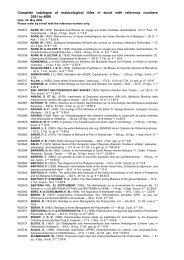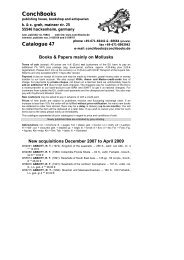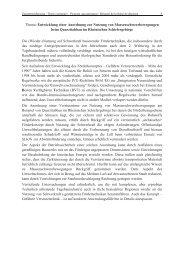Madeira Canary Islands Azores – Fishes Dr. Peter Wirtz
Madeira Canary Islands Azores – Fishes Dr. Peter Wirtz
Madeira Canary Islands Azores – Fishes Dr. Peter Wirtz
Create successful ePaper yourself
Turn your PDF publications into a flip-book with our unique Google optimized e-Paper software.
There are about 80 species in the family parrot fishes. In almost all of them, the male is colourful and the<br />
female drab grey or brown or green. It is the opposite in the European parrotfish: the male is gray (upper<br />
photo, in the foreground, being cleaned by two young Turkish wrasses), while the female is colourful (upper<br />
photo in the background and lower photo). The colour of juveniles (below) is quite variable. The teeth of<br />
parrot fishes have fused to form a beak resembling that of a parrot. With these beaks they are able to bite off<br />
fairly hard organisms (animals and plants). Most parrot fishes are prototogynous sex changers (female first,<br />
later in life male) but the European parrot fish is not: juveniles turn into either females or males. Large<br />
territorial males own a harem of females. Non-territorial males occasionally move in groups. Reproductive<br />
season July to September. All photos <strong>Peter</strong> <strong>Wirtz</strong>.<br />
114<br />
Weevers (Trachinidae)<br />
Greater weever (Trachinus draco) photo top right<br />
Up to 35 cm long. <strong>Madeira</strong>, <strong>Canary</strong> <strong>Islands</strong>. 1 <strong>–</strong> 200 m depth.<br />
Streaked weever (Trachinus radiatus) photo bottom right<br />
Up to 42 cm long. <strong>Canary</strong> <strong>Islands</strong>. 1 <strong>–</strong> 100 m depth.<br />
Lesser weever (Echiichthys vipera) photo below<br />
Up to 15 cm long. <strong>Madeira</strong>, <strong>Canary</strong> <strong>Islands</strong>, <strong>Azores</strong>. 1 <strong>–</strong> 20 m depth.<br />
Weevers usually are buried in the sand and wait for fish to catch. The Streaked weever also often lies quite<br />
openly on sandy bottom. The first dorsal fin of weevers consists of strong spines with poison glands at the<br />
base. Normally, to be stung by a weever is not dangerous but incredibly painful. Photos <strong>Peter</strong> <strong>Wirtz</strong>.









